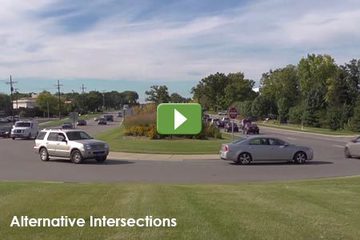October 31, 2014
Innovation Implementation: Intersection and Interchange Geometrics
The Every Day Counts effort to encourage use of innovative intersection and interchange geometrics focuses on five design features that enhance roadway safety by reducing or eliminating left-turn conflicts.
On the list are diverging diamond interchanges, displaced left-turn intersections, median U-turn intersections, restricted crossing U-turn intersections and modern roundabouts. So far, 17 states have completed demonstration projects using innovative intersection and interchange geometrics. Another 14 states have projects in the works.

Alternative Intersections: Median U-Turns.
See Video
- The Colorado Department of Transportation and city of Grand Junction partnered on a project to build the state's first diverging diamond interchange at I-70 and U.S. 6/50. The project cost $4 million, much less than alternatives with price tags of up to $15 million.
- The Louisiana Department of Transportation and Development is developing a policy to require roundabouts, median U-turn intersections and restricted crossing U-turn intersections to be considered before any new traffic light is installed.
- Minnesota's first mini-roundabout was built in the Minneapolis-St. Paul metro area at an intersection near a school. It has improved pedestrian safety and reduced traffic delays at the intersection.
Arizona Offers Intelligent Compaction Training
An Every Day Counts workshop in Flagstaff, Arizona, provided 50 participants with an introduction to intelligent compaction technology and hands-on software training. The Federal Highway Administration sponsored the October 21 and 22 event to help participants get ready for an intelligent compaction pilot project on I-40 near Flagstaff, scheduled to start in spring 2015. This winter, Arizona Department of Transportation crews will use intelligent compaction technology when making spot repairs on the interstate. The agency will investigate potential benefits of the technology, including better quality control, increased productivity, reduced repair costs, fewer roller passes, fuel savings and improved long-term durability of the highway.
Arkansas Holds Roundabout Workshop
About 30 representatives of local agencies and the Arkansas State Highway and Transportation Department participated in an October 21 and 22 workshop on roundabouts. The Arkansas Municipal League hosted the FHWA event at its North Little Rock office. The workshop covered planning, design and implementation of roundabouts. It was designed to improve communication among transportation stakeholders involved in implementing roundabouts in Arkansas.
Indiana Opens First Diverging Diamond Interchange
The Indiana Department of Transportation has constructed its first diverging diamond interchange on I-69 at DuPont Road in Fort Wayne. The agency chose a diverging diamond interchange for the location to reduce congestion. The interchange's new traffic configuration was put into operation in late September, although lane restrictions continue while median and landscaping work is completed. The state's second diverging diamond interchange is planned for 2015 near Greenwood.
Indiana Installs Next Generation Concrete
The Indiana DOT has installed a section of Next Generation Concrete Surface with longitudinal tining on I-65 as part of the reconstruction of the I-465/I-65 interchange on the south side of Indianapolis. The agency received a Highways for LIFE grant from FHWA to use this quiet pavement technology. The agency is installing three other sections of longitudinal and transverse tining on this project and collecting data to determine which type of tining produces a smoother, quieter pavement.
Rhode Island Receives STIC Incentives
The Rhode Island Department of Transportation has been allocated $100,000 in fiscal year 2015 State Transportation Innovation Council Incentive program funds to implement its first use of and institutionalize adaptive signal control technology. The Rhode Island DOT and FHWA are working with the Rhode Island Airport Corporation and Federal Aviation Administration to install adaptive signal control on six signals on a road next to T.F. Green Airport in Warwick. A runway expansion project at the airport will significantly alter travel on the already-congested road. STIC funds will help the partners hold a systems engineering workshop, develop contract documents and complete construction, as well as implement a monitoring and evaluation plan to support development of adaptive signal control programmatic guidance.


